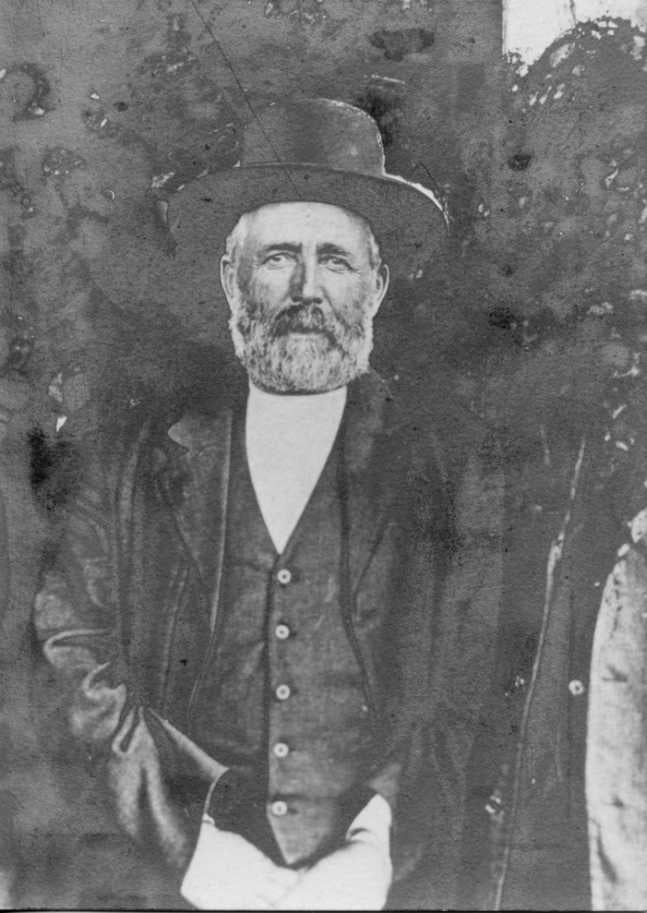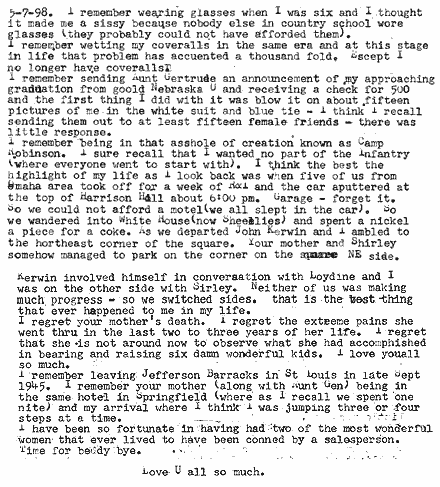
“As Time Goes By: Odebolt, Iowa Centennial 1877-1977”
Printed by The Odebolt Chronicle, 1977, Page 51-52
Donald McCorkindale (Jr.), born 1842, in Killean Parish, Argyleshire, Scotland, son of Donald, Sr. and Jeanette (McNevin) McCorkindale. His father was a farmer and emigrated to America in 1865 with his family, settling in Clinton County, Iowa. In 1870 they moved to Illinois. In 1875 they came to Richland township, Sac County, Iowa, due to the fact that nearly all their children lived here. Their children were Donald; Neil; Malcolm; Mrs. Richard Shileto; Mrs. Catharine Stuart; *Angus; and John.
Donald McCorkindale (Jr.) was twenty three when he came to America in 1865. In the spring of 1874, he came to Sac County, Iowa and bought three hundred and twenty acres of land in Clinton Township for four dollars and fifty cents an acre. As early as 1885 Donald began breeding fine draft horses, having been at the time of his death, the largest livestock breeder in the county. He imported Clydesdale stallions, which cost in the thousands of dollars to import. He exhibited his horses at county fairs. He was also a breeder of purebred Aberdeen Angus cattle.
Donald McCorkindale was married in 1876 to Mary Bremmer, also a native of Scotland, daughter of James and Margaret (Kennard) Bremmer, who came to America in 1866.Children of Donald and Mary were Jennie (Mrs. John Morton): Daniel, married Anna Story; Margaret (Mrs.Will McQuiston); Mary (Mrs. Alexander Nickolson): James, married Helen Graham; Isabelle (Mrs. George Mattes); William, married Vinta Clark; and Hannah.Mr. and Mrs. Daniel McCorkindale were parents of Francis, married Margaret Hix, and Mary (Mrs. Byron Swain).Mr. and Mrs. William McCorkindale were parents of Robert and Virginia. *Angus McCorkindale married Florence Maloney, daughter of J.S. and Frances Maloney.*Children of Mr. and Mrs. Angus McCorkindale: Kate, married Dr. H.C. Pelton; Jessie; J. Donald, married Vera McCracken; Florence (Mrs. Robert Miller); William, married Lucy Foard; Dorothy (Mrs. Clark Tilden); Kenneth; and John.
Donald McCorkindale Source: Source: Sac County, Iowa, by William H. Hart B.F. Bowen and Co., Inc, Indianapolis, IN, 1914, p. 658
In Donald McCorkindale, of Clinton Township, we had a true representative of the empire builders and one who accomplished more than the ordinary man since he came into the county nearly forty years ago and purchased a tract of unbroken prairie land. His herds of cattle and droves of horses now feed over thousands of acres of Sac County land where at first it was necessary for him to be content with a few hundred acres purchased on a time contract similar to that of the other settlers in his neighborhood.
He was known far and wide as one of the largest land owners and one of the ablest financiers of the section in a decade – yet, he was just a plain farmer, shrewd and intelligent, a son of Scotland who naturally inherited the excellent traits peculiar to his forbears.
Mr. McCorkindale was born on the 14th day of the month of March 1842, in Killean parish, Argyleshire, Scotland, the son of Donald and Jeanette (McNevin) McCorkindale. His father was a farmer in the old country who emigrated to America in the year 1865 with his family and settled in Clinton County, Iowa. Here Donald, Jr., worked in a sawmill for a period of five years and in 1870 Donald, Sr., removed to White County, Illinois, and purchased a farm. He resided in White County for five years and then moved to Odebolt, Sac County, in 1875. He was doubtless influenced to make this move because of the fact that nearly all of his children were settled in Sac County near Odebolt and he wished to be near them in his remaining days. The father died in 1895. He reared five sons and two daughters, namely: Donald; Neil, deceased; Malcolm, now a resident of Nebraska; Mrs. Richard Shileto, of Alberta, Canada; Mrs. Catharine Stuart of wall Lake, Iowa; *Angus, who died in Clinton Township in June, 1912; John a rancher in Alberta, Canada, deceased in the spring of 1914.
Donald McCorkindale was twenty-three years of age when he came to America, landing in New York City in the month of June 1865. He came west and was employed in the saw mills at Clinton, Iowa, for a period of five years. He went to Illinois in 1870 and spent two years there engaged in farming in White County. In the spring of 1874 he came to Sac County and invested his savings in three hundred and twenty acres of land in Clinton Township at four dollars and fifty cents an acre. During the first two years of his residence here he boarded and then married. Several years after marriage he made his next purchase of land and continued making additions to his holdings until he had over two thousand eight hundred acres in all.
His most recent purchase was a portion of the Cook ranch, which he bought in 1909, and consisting of five hundred and sixty acres at prices ranging from one hundred and twenty-five to one hundred and thirty-five dollars an acre. As early as 1885 he began breeding fine draft horses and met with wonderful success in this venture, having been at the time of his death the largest live stock breeder in the county. On his farm are two imported Clydesdale stallions, which cost in the thousands of dollars to import; thirty-five head of fine thoroughbred draft animals which have been exhibited at the county fairs and have carried off ribbons on several occasions. He was also a breeder of Aberdeen Angus cattle and had over three hundred and fifty head of pure breds on his home far. In addition he was an extensive feeder and shipper of live stock, handling from three to five carloads annually.
Mr. McCorkindale was the owner of a total of two thousand seven hundred acres of farm lands, two thousand five hundred acres of which is in Sac county and two hundred acres in Crawford County. This land is now being farmed entirely by the sons of Mr. McCorkindale. Practically all of the land is being devoted to the live stock breeding and now is rented out except the Cook and Wall Lake lands. It is the second largest farm in the county which has been cultivated almost entirely by the owner and is at the present time the second largest farm in Sac County in the number of acres devoted to exclusive farming and live stock raising.
Mr. McCorkindale was married in October, 1876, to *Mary Bremner, also a native of Scotland, born December 10, 1856, a daughter of James and Margaret (Kennard) Bremner, who emigrated to America from Scotland in 1866 and settled in Cedar County for seven years and then came to Crawford County in 1873, where both lie buried.
The following children have been born to Mr. And Mrs. McCorkindale: Mrs. Jennie Morton, of Alberta, Canada; Daniel, on one of the home farms; Mrs. Margaret McQuistin, of Nebraska; Mrs. Mary Nicholson, of Jefferson, Dakota; James, at home; Isabel, William and Anna, at home with their parents.
Mr. McCorkindale was an independent in politics and had definite and pronounced views on matters affecting the government of the people. He usually voted for the man who seemed best fitted for the office than for the representative of any political party. He and the members of his family have naturally espoused the religion of their forbears and were members of the Presbyterian church of Odebolt. His devoted and competent wife, who has been a wise and careful mother to her children, is still hale, hearty and intelligent, despite her advanced age. It might well be said of them that they were not old excepting in years. The home is a comfortable and hospitable one and, despite the tendency of the times for the farmer to retire to a life of ease and comfort in the towns, they preferred to remain on the farm, Donald desiring to be near the farm work and his fine live stock, and the mother desiring to care for and look after the welfare of her sons.
Donald McCorkindale passed away Monday night, May 18, 1914, at about ten-thirty o’clock before medical aid could be summoned. On the Sunday preceding he had attended church, as was his custom, and had appeared to be in the best of health. The funeral services were held on the Thursday following, May 21st, from the Odebolt Presbyterian Church in the presence of a large concourse of relatives and friends. Rev. Robert McInturff officiated at the ceremony. Burial followed in the Odebolt cemetery. Rendition of the services with song and discourse was beautiful and impressive and in keeping with the character of the deceased.



